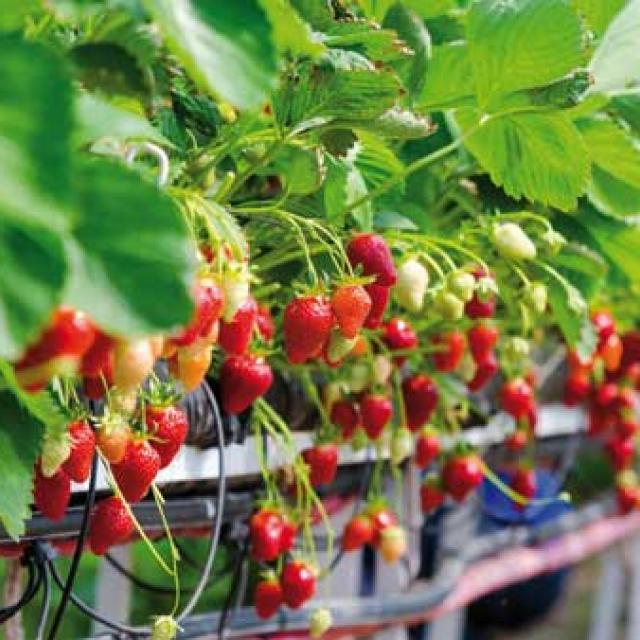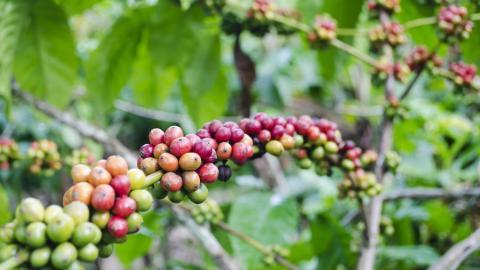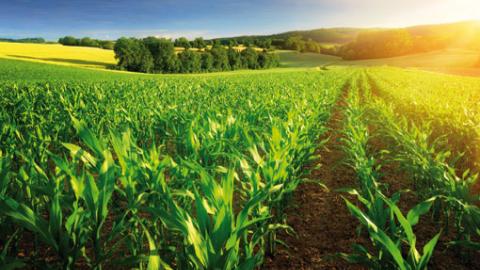The market for small fruits, also called “berries”, is constantly on the increase and growing this crop could represent an attractive opportunity for generating income,
providing the correct production techniques and strategies are adopted.
Strawberries, raspberries, blueberries, black and red currants or blackberries and gooseberries are all types of small fruits. Although their origin, morphology and taste are different, these berries all prefer similar habitats.
In their wild state they are found in mountain forest environments. The fact that they have many possible uses, combined with their recognized nutritional properties, has resulted in these crops being grown in a protected environment and made available in many shops and stores.

BERRIES MADE AVAILABLE THROUGHOUT THE YEAR!
Growing berries in greenhouses requires a particularly careful and competent form of management as there are a number of factors that could have an impact on production.
These include the climatic conditions, both inside (temperature and relative humidity of the air in a confined environment, ventilation, solar radiation and lighting, plant health) and outside (outdoor temperature and relative humidity, solar radiation, wind direction and intensity) as well as their interaction with each other
These plants also need careful monitoring of the physiological requirements at the different crop growing stages.
THE KEY ROLE OF IRRIGATION
Irrigation management is one of the most important key factors for the successful production of small fruits. The technique of fertigation (which combines irrigation and fertilization) allows the development of the crop to be controlled in the greenhouse when it is grown on a substrate and even more so in the case of growing crops in a soilless medium, with the use of techniques such as hydroponics.
In both cases the fertigation system must be able to apply the water and nutritive solutions in a uniform manner and control the electrical conductivity (EC) and pH in real time. In fact, the berries prefer slightly acidic solutions with a pH of 5.5 to 6.5 and a soil electrical conductivity (EC) of no higher than 1.7.
Furthermore, these crops require small but frequent amounts of water throughout their growing cycle, in particular during the post-transplantation and fruit-producing stages, while the application of organic matter and fertilisers must be carefully assessed on the basis of soil fertility, crop type and other specific requirements. It is, therefore, evident that the adoption of an advanced irrigation system, which uses the latest technologies, can really make a difference in terms of both product quantity and quality.
IDEAS FOR GROWING CROPS IN A SOILLESS MEDIUM…
To meet all the different requirements for growing berries, a number of soilless cultivation solutions have been developed.
This technique requires different “nutritive recipes” according to the type of crop and its phenological growth phase. One fertilization unit, managing up to 216 valves and divided into 64 blocks, can inject 2 to 4 fertilizers at the same time while measuring and controlling in real time the doses applied, in proportional mode, or according to the pH and EC value of the solution.
The prime objective of a fertigation unit is to create artificially a solution for the plants containing all the macro and micro elements required for maximum yields. The fertilisation unit can distribute up to 8 different solution recipes, which can be applied to the various irrigation sectors and define the irrigation run time in minutes, which is very useful when growing in a soilless medium, where the irrigation cycles need to be short and frequent.
Once the pH and EC values and the relative proportions of each of the required fertilisation solutions have been defined, the machine, on the basis of the information detected by the built-in sensors, regulates in real time the injection of fertilization solutions and monitors the acidity. Thus, it can be guaranteed that, during the entire irrigation cycle, the chemical parameters of the water match those set by the user. It is also possible to control the mix remotely, via a cable connection, by radio or via a dedicated online service.
The fertigation unit is the “brain” of the irrigation systems, while the “muscle” is the capillary distribution system which, in the case of irrigation systems for protected crops, can include laminar flow or on-line drippers.
The latter group includes on-line drippers that allow flow rates of 1.1 to 2.1 liters /h, specially developed by Irritec for the soilless growing of crops such as strawberries or red and black currants, which require a low flow rate and very precise distribution.
These drippers are pressure-compensating and have an anti-drain system to prevent the water and nutrient solution from flowing towards the plants positioned further downstream. These drippers have different hourly flow rates and, with their special manifolds (multiplier fittings), they are able to irrigate 1 to 4 pots or plants. In order to make installation simpler, on-line drippers are supplied in pre-assembled kits with a special spike or stake and tubes of different lengths, depending on the requirements, white in colour to reduce the temperature of the water that remains inside the system between one irrigation cycle and the other.
…AND FOR GROWING IN SOIL
A capillary flow drip irrigation system has been developed for growing crops in soil. Although the principle is simple, maximum precision is required in its design and installation. In fact, the flow-rate of each individual capillary is directly proportional to the pressure, its length and its inner diameter.
In order to meet the needs of crops grown in containers on different substrates, there is a range of different capillary tubes available in terms of inner diameter (ranging from 0.6 mm to 1.5 mm), insert spacing between one capillary and the other (ranging from a minimum of 7 cm to a maximum of 999 cm) and the lengths (from 40 to 94 cm).
Furthermore, it is possible to choose the colour of the tube, black or grey, which is less susceptible to an increase in temperature due to solar radiation. Another solution for growing on a substrate is the driplines with built-in flat drippers. In the case of water containing large quantities of suspended particles, it is advisable to use driplines with larger filter surfaces.
Driplines with low hourly flow-rate (0.3 to 1.2 liters/h) and reduced spacing between drippers (7.5 to 40 cm) are particularly suitable for the irrigation of strawberries and berries in very sandy soils and especially during transplanting when the root zone has to be wetted to encourage rapid root development.
During this phase, the possibility of water stress, albeit low-level, could irreparably compromise the yield. To avoid these problems, it is advisable to irrigate a few days before transplanting in order to promote better and faster root development in the new substrate.
Apart from using driplines to apply the water and nutrient solutions, it is also possible to apply in a precise and timely manner the phytosanitary products necessary for treating the soil against insects and other pathogens of the root system.
Most of the systems available for growing small fruits in green houses are characterized by covering the substrate with mulch, so as to reduce weeds and evapotranspiration. In these systems, in addition to the driplines installed under the mulch, a second irrigation system, using sprays or sprinklers, is installed to cool the air in the greenhouse and thus reduce evapotranspiration.
In this case, it is advisable to use sprays, sprinklers or foggers/misters, if the aim of installing the irrigation system is to increase the humidity of the air or lower the temperature.



